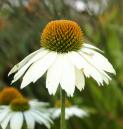The root of Anacy'clus pyre'thrum (Linné) De Candolle. Preserve in tightly closed containers, adding a few drops of chloroform or carbon tetrachloride, to prevent attack by insects.
BOTANICAL CHARACTERISTICS.—Root long, fusiform. Stems numerous, branched, pubescent. Radical leaves pinnatifid, stem-leaves sessile. Florets of the ray pistillate, white above and purplish beneath; of the disk, yellow, tubular, 5-toothed. Akene flat, winged; pappus short.
SOURCE.—Mediterranean Basin, coming solely from Algeria, thence to Mediterranean points.
 DESCRIPTION OF DRUG.—A hard, compact, somewhat fusiform root, about the size of the little finger, with sometimes leaf -remnants at the top, and beset with few or no hair-like rootlets; externally brownish, deeply fissured longitudinally. It breaks with a short fracture, showing a rather thick bark adhering closely to the pale brown wood, from which it is separated by a narrow cambium line. This woody column is traversed by broad, distinct medullary rays, and contains as does also the bark, large scattered resin ducts. Odor very slight; taste slight at first, but afterward persistently acrid, leaving a singular tingling sensation in the mouth and throat, and exciting a remarkable flow of saliva.
DESCRIPTION OF DRUG.—A hard, compact, somewhat fusiform root, about the size of the little finger, with sometimes leaf -remnants at the top, and beset with few or no hair-like rootlets; externally brownish, deeply fissured longitudinally. It breaks with a short fracture, showing a rather thick bark adhering closely to the pale brown wood, from which it is separated by a narrow cambium line. This woody column is traversed by broad, distinct medullary rays, and contains as does also the bark, large scattered resin ducts. Odor very slight; taste slight at first, but afterward persistently acrid, leaving a singular tingling sensation in the mouth and throat, and exciting a remarkable flow of saliva.
555a. Pyrethrum Germanicum, from Anacyclus officinarum Hayne, is of a grayish color, about half as thick as above, tapering to filiform at the lower end; has long been cultivated near Magdeburg and in Saxony. It resembles the above in foliage and flowers.
CONSTITUENTS.—A very acrid resinous substance, two acrid oils—pyrethrine, extracted by ether (crystalline, bitter, burning taste), which under action of alcoholic KOH decomposes into piperidine. Most of the parenchymatous cells are loaded with inulin, which forms about 35 per cent. of the root. Ash, not more than 5 per cent.
ACTION AND USES.—Used almost exclusively as a sialagogue in headache, neuralgic and rheumatic affections of the face, toothache, etc., or as a local stimulant in palsy of the tongue or throat, or relaxation of the uvula. Dose when chewed: 30 to 60 gr. (2 to 4 Gm.).
- OFFICIAL PREPARATION.
- Tinctura Pyrethri (20 per cent.) Used externally.

